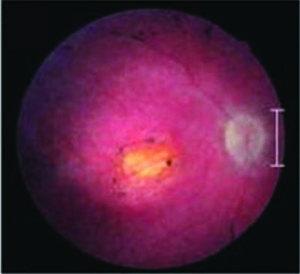Koenekoop RK, Wang H, Majewski J, Wang X, Lopez I, Ren H, Chen Y, Li Y, Fishman GA, Genead M, Schwartzentruber J, Solanki N, Traboulsi EI, Cheng J, Logan CV, McKibbin M, Hayward BE, Parry DA, Johnson CA, Nageeb M; Finding of Rare Disease Genes (FORGE) Canada Consortium, Poulter JA, Mohamed MD, Jafri H, Rashid Y, Taylor GR, Keser V, Mardon G, Xu H, Inglehearn CF, Fu Q, Toomes C, Chen R. Mutations in NMNAT1 cause Leber congenital amaurosis and identify a new disease pathway for retinal degeneration. Nat Genet. sept 2012, 44(9):1035-9.
Scientific impact: Leber’s congenital amaurosis (LCA) is an ocular disease which causes a severe macular atrophy and vision loss within first year of birth. This disease is poorly understood and while many gene defects can lead to its development, up to 30% of cases have no linked mutations. This paper presents the discovery of a novel gene related to LCA, NMNAT1, essential for neuronal survival and function. This discovery could also lead to a new therapeutic avenue through the use of NAD, a product of NMNAT1 enzymatic activity which considerably slows axon degeneration in mouse.
Network contribution: This work, financed in part by the VHRN, highlights the expertise of network members in this major international collaboration.
* * *
Original abstract
Leber congenital amaurosis (LCA) is a blinding retinal disease that presents within the first year after birth. Using exome sequencing, we identified mutations in the nicotinamide adenine dinucleotide (NAD) synthase gene NMNAT1 encoding nicotinamide mononucleotide adenylyltransferase 1 in eight families with LCA, including the family in which LCA was originally linked to the LCA9 locus. Notably, all individuals with NMNAT1 mutations also have macular colobomas, which are severe degenerative entities of the central retina (fovea) devoid of tissue and photoreceptors. Functional assays of the proteins encoded by the mutant alleles identified in our study showed that the mutations reduce the enzymatic activity of NMNAT1 in NAD biosynthesis and affect protein folding. Of note, recent characterization of the slow Wallerian degeneration (Wld(s)) mouse model, in which prolonged axonal survival after injury is observed, identified NMNAT1 as a neuroprotective protein when ectopically expressed. Our findings identify a new disease mechanism underlying LCA and provide the first link between endogenous NMNAT1 dysfunction and a human nervous system disorder.
Retina of patients with NMNAT1 mutation



